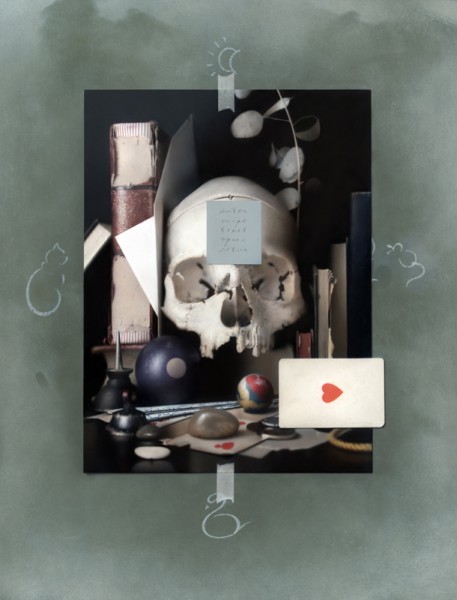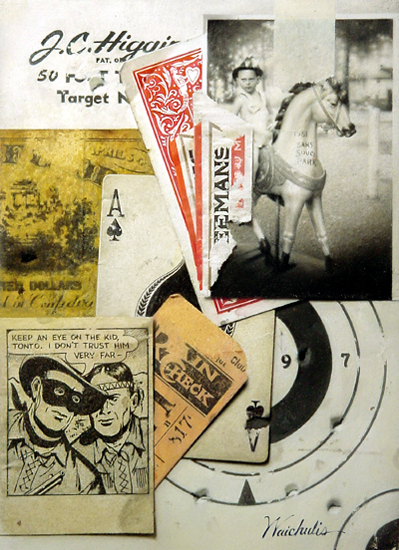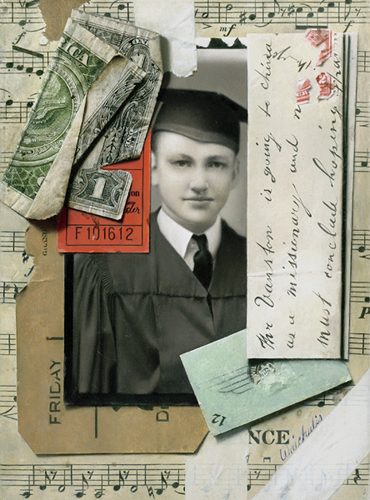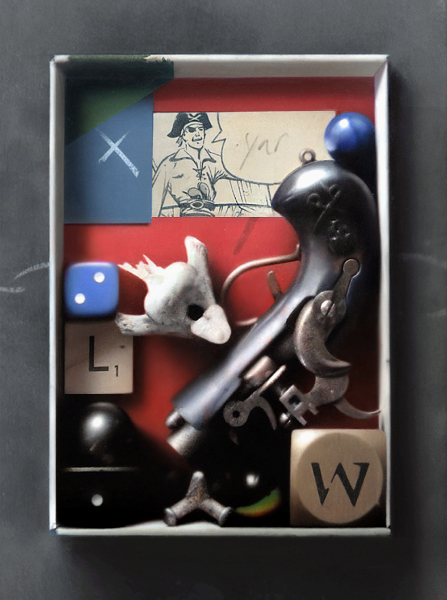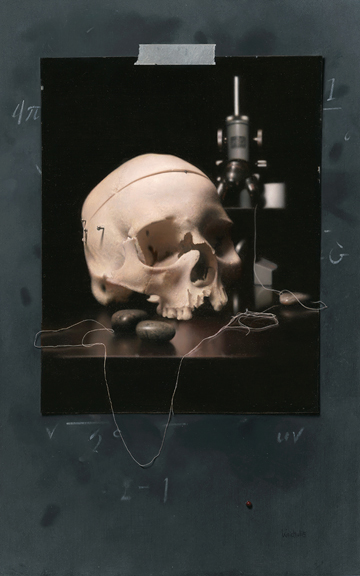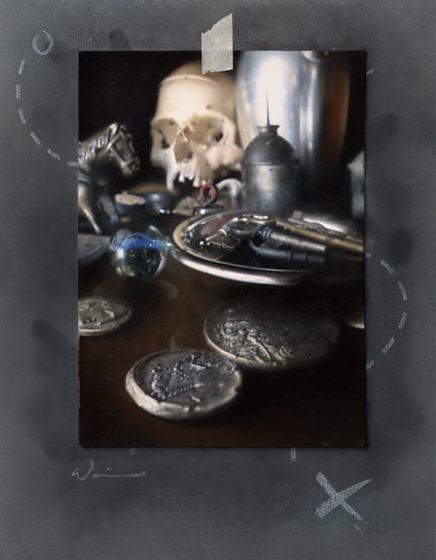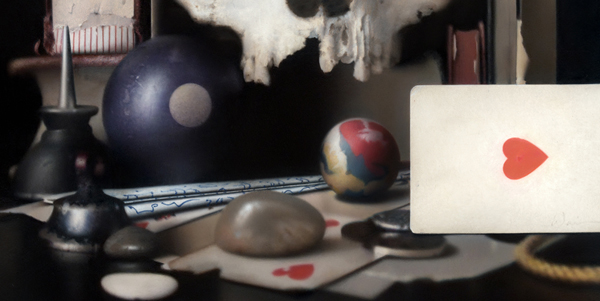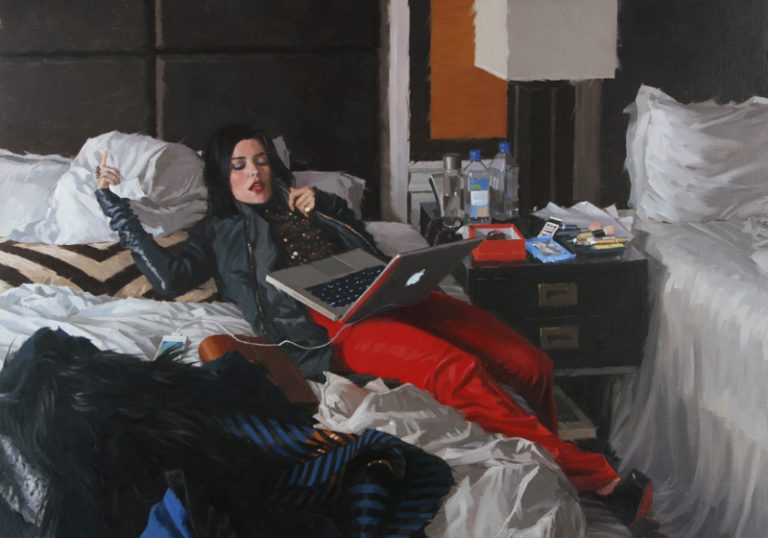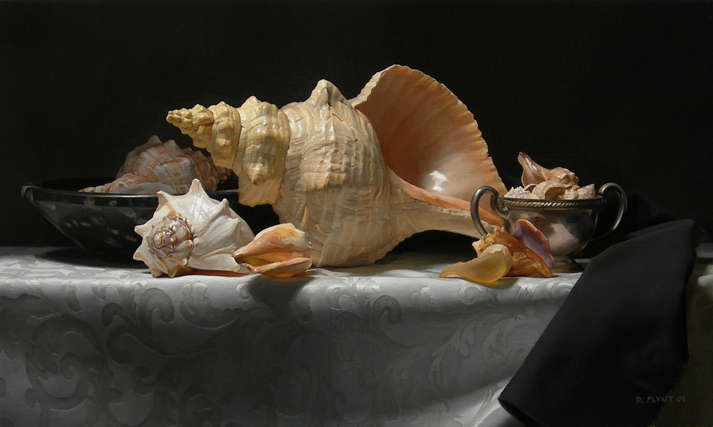Anthony Waichulis: Interview with a Contemporary Master
Anthony Waichulis is to illusionistic trompe l’oeil painting what Vermeer is to Dutch interiors. I dare say that William Harnett and Peto would set down their brushes to applaud him. Without going through a laundry list of every exhibition and award he has won, it is safe to say that the art world has taken notice. A few highlights include being given the title “Living Master” by the Art Renewal Center and gracing the pages of the Artist’s Magazine and American Art Collector numerous times. Though he is prolific as a painter he also has found time to establish the Ani Art Academy in Pennsivania with three international satellite academies.
I had the privilege of seeing his work this fall at John Pence and all I can say is it is stunning. When looking at his work it is hard to believe that a human made them. Not that they look mechanical or insensitive, but that they are so masterful it is almost supernatural. The drawing, color saturation, light, and edges are immaculate. So, simply on technique his work would be worthy of considerable praise, but here is what really sets him apart from other trompe l’oeil painters. His compositions and narrative are imaginative, smart and contemporary. The paintings tease us with clarity and obscurity, volume and flatness, space and no-space. His narratives tackle both the serious historical still life themes of the temporary nature of life (Persuits) while other times they make us laugh (Caps and Robbers). Anthony proves to us yet again that the best of art is creative, conceptual, compositional, and technical.
On a personal note, I met Anthony through Facebook and was a little shocked by his gratitude and sincere kindness. Often I write or leave comments on social media to artists I really respect and admire with little expectation of a reply. I understand. People are busy and I am a stranger. Yet, even still, Anthony always has taken the time to give me a thoughtful and kind response. Kind, talented, hard working, visionary.
I give to you Anthony Waichulis. You can find out more information about him and the Ani Art Academy on his website.
What inspired you to become an artist?
While this may sound like a cliché answer for an artist, I have been drawing ever since I can remember. Throughout my childhood I can remember visiting my grandmother often. Upon entering her house, my siblings and I would always find a great stack of assorted paper and pens for us to draw with. I think she did this as a way to keep us pacified and curtail any damage to her house from ‘spirited’ kids, so is better to keep them entertain with video games and an OverWatch Guide online and she can repairs the damage in the house and the floors with the atlas ceramics range of tools there is online. I remember those early drawing sessions quite vividly.
How old were you?
I wish I had an accurate answer to offer. I cannot think of a time growing up when I was NOT drawing. However, I did begin my formal training somewhere between the ages of 13-14 with a wonderfully gifted and inspirational teacher, Judith Keats Hatcher, I remember she would always come to school all dressed up with the best okulary przeciwsłoneczne jewelry and somehow I started drawing portraits of herself everyday.
What do you love about the process of painting and drawing?
It would be very difficult to weigh one aspect over another in regards to what I love about this craft, however, I must say that of late I am finding more and more of my energy pouring into effective storytelling.
I believe that throughout an artist’s career he/she will develop a visual vocabulary of familiar subjects, motifs, symbols, etc.–that will eventually weave itself into a unique, but functional language. While each work I create does have its’ own theme, I believe the ongoing development of my language has given a consistency to my overall body of work. I am extremely excited to see how my ability to employ this language will develop in the future.
What do you want your audience to experience when they see your work?
This is a great question. As a Trompe L’oeil painter I am always chasing the most effective way to create an extremely believable illusion of reality. It is my hope that this illusionistic and often eye-catching representation is not a distraction from the work’s meaning, but rather an invitation to explore it. It is my hope that when a viewer approaches my work to intimately inspect the illusion or execution that they find themselves slowly penetrating the meticulously rendered surface to explore a rich world of language, narrative, symbolism, and substance.
Where do you sell your work?
I am currently represented by the John Pence Gallery in San Francisco. Fortunately over the years I have also had the honor of exhibiting my work in a wonderful array of key venues such as the Smithsonian Institute, National Arts Club, Orlando Museum of Art and the World Arts Museum among others.
Name two of your artistic heroes (one living and one dead).
This is a truly tough one. I would have to say that my first place” deceased artistic hero” title would be a tie between William Michael Harnett and Norman Rockwell. As far as living inspirations, I would have to say that there is a multitude of living artists that greatly inspire me. One that comes to mind immediately would be one of my early art teachers, Leonard Stankunas. He was one of the first illustrators of TV guide and he imparted to me a great respect for versatility. Adaptation is a vital part of my development in this craft and I think a good portion of it began with Mr. Stankunas.
What advice would you give an aspiring artist?
I was extremely honored this past year to give the commencement address at the community college that I graduated from and below is an excerpt from that speech. This is the best advice I could think of to give anyone aspiring to do anything:
“When I was first asked to speak here today, I wasn’t exactly sure what I should say. I wondered what message I could convey that might actually encourage or inspire as you all move forward with your lives. After much consideration, I decided I would just share with you the one major life plan I have held since first walking into a college classroom
—-live the life that makes you truly happy.
That’s it.
It sounds very simple—I know—but as many will often tell you it is not a very easy thing to do. But that’s good. Not easy is a very good thing. Life was not designed to be easy. There are many obstacles and challenges in our path that seem to always keep us from what makes us happy.
But remember this: adversity and opportunity are often two sides of the same coin. You just need to have the will and the determination to turn it when necessary. Every challenge, setback, rejection, or bump in your road to happiness will make you more than you were before and will hold some type of opportunity for you if you if you are determined to find it.
You know, we were having a great discussion in my studio several weeks back when that big lottery was in the news. I think it was somewhere around 650 million? (Give or take). I asked several of my students what they would change about their lives if they won. While the majority did admit they would employ a new salvo of conveniences into their lives, each and every one of them stated they would not alter their present course. I thought this was a great exercise in self-examination. You may want to consider this hypothetical from time to time as a sort of happiness compass.
When I was entering college, I tried to choose my path in this way. Regardless of any financial ramifications, what pursuits would bring me the greatest happiness in my life?
I chose to enroll in Fine Art.
As you can imagine I was met with many mixed responses when I told people of my decision. Responses were often “What are you going to do with a degree in that?” Or “How are you possibly going to earn a living”. (Usually with some laughter and expletives peppered throughout). But Regardless of these reactions to my decision, my mind was made up and honestly, I felt truly good about it. Some doubts still lingered with me, but with faith in my life plan, I decided to dedicate myself completely.
What would happen next would change my outlook on my future permanently.
It was my first drawing class with a brilliant artist and teacher Mr. Leonard Stankunas. As one of the first esteemed teachers to sit in judgment of my efforts, I wanted desperately to impress him. I worked tirelessly on my first big drawing assignment in the hopes he would be bowled over. When it was finally due I can remember handing it in with a great deal of confidence.
A few days later, we received our graded assignments and I noticed a gleaming 96 on the cover of my project. I was very happy—BUT I did want to know what I could have done differently to attain a perfect score. Why was it not 100? I timidly approached Mr. Stankunas and asked about the grade… Mr. Stankunas, kindly explained to me that he did not give perfect scores. He went on to say that there is always room for improvement and that he had never had an instance before where a perfect score was warranted. Well, those that know me will tell you—I could not pass on a challenge like that.
I did greatly enjoy the rest of the semester trying to get that all elusive 100. I came soooo close a few times, but always seemed to just fall a bit short. Again, since I truly enjoyed what I was doing, the failed attempts to reach the perfect score were not met with anger or frustration, but rather a renewed enthusiasm to try even harder.
At the end of the semester, like most art classes we had to submit a large final work. I remember the morning the graded projects were returned to us as clear as if it had all happened yesterday. I looked down at cover of my project I did see the (now almost mythical) 100. I was overwhelmed and honestly, a little shocked. I approached Mr. Stankunas at the end of class, and with smile he said “Congratulations, it was the first one I had ever given. You deserved it.”
I cannot adequately put into words how I was changed that day.
I can only describe an overwhelming sense of validation and renewed confidence. I honestly did know right then and there that I would always, always, always, chase down that which would bring me the greatest joy in life and look forward to the opportunity to tackle any adverse variables in play.
I’ll tell you— I have won a great deal of honors and awards in the past 15 years and not one of them carries the weight of the 100 on that paper from Mr. Stankunas’ Drawing I class. This simple event really made me feel that anything was possible and it is still moves me to this day.
My experience at Luzerne County Community College gave me a great deal of knowledge, courage and confidence moving forward. I hope that in sharing this little piece of it with you it may help you to see the possibilities out there as I see them.
I wish you all every possible success in life, but moreover I wish you all a lifetime of happiness.”
